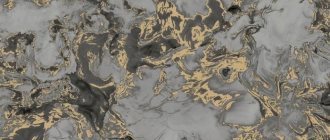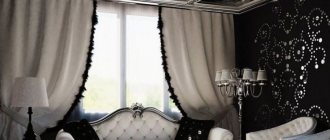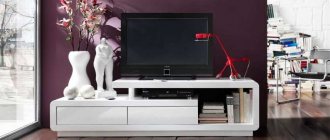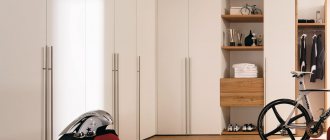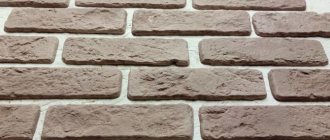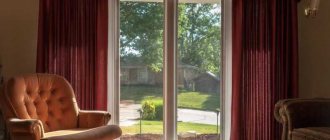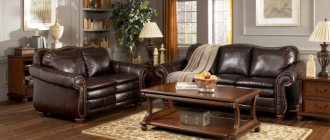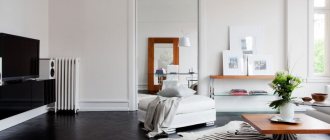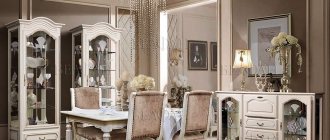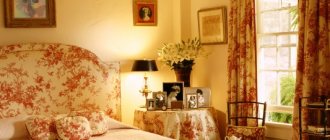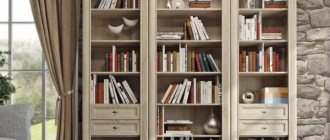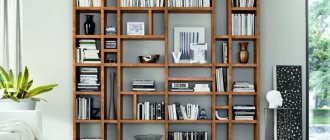Here you will learn what liquid wallpaper is, what pros and cons owners will face when decorating their home this way, how to inexpensively create liquid wallpaper with your own hands, and also get acquainted with photos of professional finishing and design of a bedroom, living room and children's room!
- Living room and bedroom
The choice of finishing materials, from decorative plaster to liquid and glass wallpaper, is becoming more and more diverse, so it is becoming increasingly difficult to choose an alternative to the classic paper rolls. Without deviating from advertising, let’s try to fairly understand all the advantages and disadvantages of liquid wallpaper, methods of applying it and options for decorating various rooms with it. First, let's find out what they are.
Types of liquid wallpaper
Today, the building materials market offers a huge number of new liquid wallpaper products. In turn, they are divided into several types:
- Models with silk-screen printing. The product contains up to 50% silk threads, which after drying create a shiny texture. This option of decorative material is considered the most expensive among other types of liquid wallpaper;
- Paper and pulp. They are characterized by a short service life and the smallest amount of decorative materials. Their cost is much lower than that of silk models;
- Cotton. The presence of cotton particles makes the coating softer and more uniform;
- Models based on silk and cellulose. The composition uses silk and cellulose components;
- Moisture-resistant models. This type of decorative coating can be used to decorate a bathroom, bathhouse and even a sauna. These models use special additives that repel moisture and prevent its penetration into deep structures. The use of transparent acrylic varnish will help increase the water-repellent effect. To do this, it is enough to cover the walls with a thin layer to prolong the performance of the decorative coating. Caring for such walls is easy and simple. To do this, just wipe them with a soft cloth and soapy water.
What substances are used for production?
To create this version of the finishing material, the following components are used:
- Adhesive base. This material is made in the form of a dry powder, which after contact with water increases in size and promotes adhesion of the decor to the concrete plane;
- Dyes. They allow you to paint the working composition in the required shade;
- Pulp of different sizes. For the production of liquid wallpaper, paper of different compositions and strengths is used. It is she who sets the texture and volume on the surface of the wall;
- Small fibers of silk threads. They provide the finished surface with shine and silky texture;
- Antiseptics and fungicides. These substances prevent the growth of bacteria and fungi on the surface;
- Decorative details in the form of mica, mother-of-pearl chips, sparkles of different diameters and mineral chips.
The material for decorating the interior space is sold in the form of a dry powder, which is pre-packaged in containers of different diameters. The shelf life of such finishing material is from 10 to 15 years.
Compound
As mentioned above, high-quality liquid wallpaper does not contain critical ingredients that can be harmful to health. An exception may be low-quality products from unscrupulous manufacturers.
- Liquid wallpaper is based on cellulose or cotton fiber, which makes up about 90% of the total composition. Often, waste paper, wood and textiles are used after recycling.
- Additives to improve technical characteristics. Antiseptics are added to increase resistance to mold, mildew and bacteria on the surface.
- Membership Basis. You can use an envelope, PVA, wallpaper glue, or paste as glue.
- Various types of decorative additives. Additives solely for aesthetic effect and texture: beads, sequins, silk fibers, dyeing, flock, velor.
Pros and cons of liquid wallpaper
What is better, liquid wallpaper or regular wallpaper? Experts highlight both the positive and negative aspects of this type of decorative coating. Benefits include:
- Easy and quick to apply. According to positive reviews of liquid wallpaper, the repair process does not exceed 10 hours;
- Does not accumulate dust. The product contains special additives that have a dust-repellent and moisture-proof coating;
- They have good thermal insulation. Such wallpaper reduces the occurrence of drafts;
- Environmentally friendly composition. As noted above, chemical components and toxic substances are not used to produce this model of finishing material;
- During the application process, no joints are formed and the decorations do not need to be combined with each other;
- They have good soundproofing qualities. Cellulose, in contact with polyvinyl chloride compounds, forms a dense shell on the surface of the wall, which perfectly absorbs loud sounds;
- Cracks do not appear even after prolonged use;
- Some types are excellent at absorbing moisture. For example, when choosing liquid wallpaper for the kitchen, you must take into account the presence of additional moisture-repellent impregnation. Its presence is indicated in the product composition. In the cooking area, there is always increased humidity and temperature changes, which negatively affect the condition of decorative coatings;
- They can be used to create three-dimensional images on the surface of the ceiling and walls. For example, when creating designs with liquid wallpaper, you will need a more dense composition. To do this, in the process of preparing the working composition, the proportions of water are reduced by one and a half times. In this way, a porridge-like substance is obtained, which is easy to create a three-dimensional texture or a peculiar pattern;
- Easily demonstrated. To do this, you can use a regular construction spatula. If deformations from animal nails appear on the wall, then a small amount of the composition can correct the situation and return the interior to its original appearance.
The disadvantages of liquid wallpaper include its long drying time and the ability to absorb excess moisture if the finishing material does not have additional moisture-repellent impregnation.
Color palette
Liquid wallpaper is an excellent finishing material for any type of surface, be it a ceiling or a wall. They gained their popularity and demand thanks to a huge palette of colors and textures. A wide range of colors allows you to choose from the lightest to the darkest tones in any area of the spectrum.
The magic wand in the design of the establishment is the “flower wheel” shown in the photo below. Thanks to him, even a beginner can cope with the color scheme. Designers are encouraged to choose background colors that are on the opposite side of the spectrum to create contrast; neighboring tones are used to highlight similar tones.
To decorate a separate room, its individual colors are selected. So, for office premises, strict shades of gray or beige will help create a corporate atmosphere. To make the coating more refined with a touch of charm, special additives are added to the dough. For example, gold threads can add luxury.
To achieve different color effects, manufacturers begin to create specific compositions. They can contain natural fibers of cotton, silk, cellulose, as well as various dyes, all kinds of crumbs, and so on.
Manufacturing companies can sell such mixtures either in one package, where all the components are already mixed, or in a kit, which includes several packages, where each component is separately.
Mixing should be done in accordance with the instructions on the material packaging. Then there are tips on creating a specific shade and what will pair perfectly with what.
Through the efforts of manufacturers and designers, collections of such wallpapers have been created, which differ not only in composition, but also in color saturation. Most of them are available in soft, soothing colors that help create a cozy and comfortable atmosphere in the room.
Despite the huge variety of colors, solid matte tones are even closer to liquid wallpaper. They mainly play a supporting role in interior decoration. But if you want, you can always create a bold interior by adding a little brighter paint.
A wide palette of colors and various textures allow you to create original visual effects, convey the volume of the image and the depth of the idea. And the different direction of application also allows you to add a play of light and shadow to such a wall.
Liquid wallpaper application technology
How to apply liquid wallpaper? Experts have developed several methods for applying the working composition to a vertical and horizontal plane. They include:
- To finish the ceiling, use a flat spatula. A small amount of the working composition is applied to it. Next, the decorations are evenly distributed in a circular motion. The surface is first carefully treated to remove external defects and primed;
- For finishing the kitchen, we recommend purchasing an additional supply of consumables. The corner parts of the space are treated with the working composition. Movements are carried out from bottom to top;
- To treat plasterboard structures, the entire frame is puttied with a finishing mixture. After this, it can be coated with acrylic paint.
Liquid wallpaper consumption
What is the price and consumption of liquid wallpaper per square meter? Experts recommend spending an average of 1 sq.m. 0.5 kg of dry composition. The purchase price directly depends on the area of the room and the presence of external effects.
For an even surface you will need from 0.3 to 0.5 kg. It is also necessary to take into account the inclination and movements of the spatula during the application of the working composition to the walls. For example, if you hold a construction spatula at an angle of 45 degrees, then approximately 0.2 kg will be consumed during application.
Flaws
Despite all the advantages, liquid wallpaper is still not as common as traditional wallpaper for the following reasons:
- High price. Traditional ones have a wider range of prices, which is required for any wallet. Liquid ones are more expensive, on average about 1000 rubles. And more per kg of dry matter. Approximate consumption: 1 kg per 4-5 m2. The smaller the particles in the mixture, the higher the cost.
- More limited color selection. The range is expanding, but still inferior to the usual ones.
- It cannot be washed. You can paint the surface with acrylic paint, but this will deprive it of breathability.
- If there was a stain of a contrasting color under the decorative layer, over time it will appear on the outside.
- It takes an average of 2-3 days to dry, depending on the season.
Liquid wallpaper is purchased dry, after which it is diluted with water before use. The mixture is suitable for application to walls, ceilings, structures of any shape.
Liquid wallpaper at home
How to make liquid wallpaper with your own hands? Today, the assortment of construction stores offers a huge number of finishing and consumable materials. However, many consumers prefer to create this type of decor at home. What will be needed to create a workforce? This list includes:
- Paper. To prepare the building composition, you can use absolutely any type of cellulose. The paper base is first crushed into small pieces;
- Next, we use color pigments, dry polyvinyl chloride, glitter, silk fibers and pearlescent powder;
- Mix all components thoroughly with each other. Then add water. The consistency should be similar to thick sour cream.
If the decorative base begins to peel off, then experts recommend adding more adhesive base. If cracks appear, filler must be replenished. The photo of liquid wallpaper shows the result of decorating a vertical coating.
How to work with liquid wallpaper?
How to apply liquid wallpaper yourself? To do this, it is recommended to adhere to the following instructions:
- First, place the contents of the package in a deep container;
- Next, add the required volume of water indicated on the package;
- After which it is recommended to properly prepare the wall. To do this, all irregularities are removed using putty;
- Now, using a construction spatula, carefully distribute the working composition at an angle of 45 degrees. In this way, it is possible to reduce the consumption of decorative coating;
- The temperature in a closed space should be between 18 and 20 degrees. If it is lower, the risks of detachments and external deformations increase;
- When applying a decorative coating, the entire surface is carefully worked with a rubber flat spatula. In this way, it is possible to create a perfectly level base for further finishing.
Dyeing process
If, after finishing the walls with liquid wallpaper, designers are not satisfied with the color, then this defect can be corrected by painting the walls. For work, water-based types of coloring compositions are used. They are well absorbed into the porous structure and make the surface uniform.
To apply coloring pigments, use a wide brush. This type of tool allows you to paint over voids and minor imperfections well. During the dyeing process, you should not make sudden movements. The fact is that coloring pigments penetrate deeply into the cellulose structure, thereby provoking its destruction.
Finishing of non-standard surfaces
The big advantage of this material is that it can be used to decorate not only walls.
Ceiling
This practice is often used to decorate protrusions on stretch ceilings, as well as in the toilet and bathroom. This is done not only to save material, but also to maintain the overall aesthetics of the room.
Arch
The design of the arch is no less original. Especially when the liquid wallpaper has a stone or wood print.
